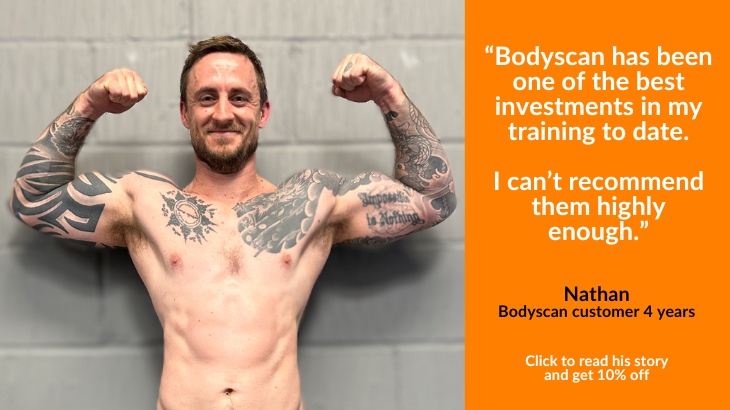
BODYSCAN DATA
Bodyscan Limited must be acknowledged as the source if any of the tables, charts or other information from this page or elsewhere on this website is used externally.
The tables and charts on this page represent scan data from more than 17,000 DEXA body scans – over 11,000 men and 6000 women, scanned at Bodyscan’s two London facilities between January 2015 and July 2022. The data does not, of course, represent a random sample of the UK population (there is a geographical bias and each client chose to have and pay for a scan). That said it represents the biggest UK sample of DEXA body composition data.
Significantly, while the sample is self-selecting (Bodyscan clients), it is not skewed towards athletes or unusually active individuals. University studies are often made up of small sample sizes picked from sports science departments.
The body fat percentile charts will be of most interest to existing Bodyscan clients who can compare the data in their own report with the larger client base. At every Baseline scan, each customer’s scan results are plotted against the Bodyscan cohort to provide an easy-to-read visual representation of his or her DEXA results.
How to read the body fat percentile tables
The tables below show a range of body fat percentiles (1st, 99th and each decile) for a range of DEXA data points. For example, in the body fat table for men (below), the 20th percentile for Fat Mass Index (FMI) for men aged 30-39 is 4.33. This means that 20% of men in that age range have an FMI below this figure and 80% have an FMI above it. It means that a male with a fat mass index of around 4.3 is in the “top” 20% of all male Bodyscan clients. Fat Mass Index is the amount of fat a person carries in relation to their height.
On the same table, the average (median) result for visceral fat for men aged 40-49 is 83.1. You can see by looking at the age ranges in the DEXA scan data that visceral fat rises quite steeply as we get older.
The table below shows lean mass and bone results for a man in his fifties. His Lean Mass Index (LMI) of 21.8 is in the 90th percentile, meaning he has more lean mass (which can effectively be read as skeletal muscle) for his height than 90% of men his age. That is the kind of muscle mass a professional body builder might have. However, very high lean mass and muscle can be the result of being very obese; the musculature adapts to carrying excess weight (in the form of body fat).
In the three rows below LMI, the arms, trunk and legs lean mass shows him to have, proportionately, most of his muscle in his legs (11.49kg), followed by his arms (3.54kg) and then upper body or trunk (26.5kg). For these three rows we are not really interested in the precise percentiles, simply in the pattern – the relative position of each of the body regions.
Finally, this man has low bone mineral density (bottom row). A result of 1.00 puts him in the bottom first percentile. We would advise he follows up with his doctor.
Similarly (see table below), if you’re female and aged 40-49, a Lean Mass Index (LMI) score of 17.5 will put you in the 80th percentile. With that score, it means you carry more lean mass (essentially skeletal muscle) for your height than 80% of women in your age range.
On the same table, the average bone density (BMD) result for women aged 18-29 is 1.13.
For the female client in her 30s below, we see a big discrepancy between body fat percentage (BF%) and Fat Mass Index (FMI). This will be because she has high muscle mass, which numerically pushes BF% down (if a lot of you is muscle, then a smaller proportion (percentage) will be fat. FMI strips muscle out of the equation and looks at fat on its own.
The fat she carries is atypically in her upper body (Trunk/Limbs ratio) and belly (Android/Gynoid ratio). At the right-hand end of these rows which show fat distribution, body fat is being stored in the upper body and belly. At the left-hand end, body fat is atypically in the arms and legs.
As a result of her fat distribution, her visceral fat (Est VAT in the bottom row) is at 54.7. We normally expect visceral fat and FMI scores to be in the same percentile, thus we would expect her VAT score to be lower, around 36.5. The higher visceral result is because of her top-heavy fat distribution – this will inevitably lead to some of that trunk fat being stored internally.
Some things to note:
The median ages in each age range are, coincidentally, the same for both sexes: 26, 23, 44, 54
“Top” versus “bottom” and “good” versus “bad” – generally speaking, you will want your fat indices to be low and your lean numbers to be high (ie, a person typically wants to have lower body fat and more muscle mass than most other people). Therefore most people will strive to be below the 50th percentile for their fat numbers and above the 50th percentile for their lean data. That is, if you want to be in the “top” 10% (the 10th percentile) for your fat mass index (FMI), aiming to be in the “top” 10% for your lean mass index (LMI) means that you will be aiming for the 90th percentile (not the 10th).
Similarly, being at one extreme end of the percentile scale (in the 1st or 99th percentile) may not necessarily be a “good” thing. It could mean, for example, that you have unhealthily low levels of fat. With ratios, such as the Trunk/Limb fat ratio, being in the 1st or 99th percentile simply means that your fat is either vastly more in your trunk or in your arms and legs – neither “good” or “bad”, just not typical. For ratios like these, a figure around the 50th percentile might be considered more “normal” or typical. Remember, though, you cannot change your fat distribution, it is what it is!
Abbreviations:
BMI = Body Mass Index (weight divided by height-squared)
FMI = Fat Mass Index (fat mass divided by height-squared)
LMI = Lean Mass Index (lean mass divided by height-squared)
Est VAT = Estimated Visceral Adipose Tissue (visceral fat)
Bodyscan Limited must be acknowledged as the source if any of the tables, charts or other information from this page or elsewhere on this website is used externally.
Please check our FAQs first!
Our FAQs give info on Prices, Making a Booking, Having the Scan and Prepaid Packages.


